
The Brooklyn Rail’s November 2015 issue is dedicated to the intersections between art and ecology! Guest editor Greg Lindquist poses some of the same questions discussed in Science Forward though specifically focuses on the question of whether or not art can play any role in communicating the impact of environmental damage to the general public:
“What function, then, should art serve in the context of the current environment and social concerns, and to what degree of efficacy? Should it solely problematize, polemicize or theorize? Or can art provide an aesthetic, emotional, and beautiful experience while empowering direct environmental action and policy change? Can beauty infiltrate and influence public opinion?”
Click here for the rest of his Editor’s Message column titled “Social Ecologies.”
This issue contains a piece titled “Remixing Messages: A Call for Collaboration Between Artists and Scientists” written by the artist Mary Miss:
The environmental issues facing us as a result of climate change are daunting. Scientists are doing important research to address the complex topics such as water supply, food access, air quality, and temperature rise that accompany global warming. Artists are in a unique position to reflect on these topics and engage people with issues that are hard to imagine because they are happening someplace else or in the future. How can these disciplines begin working together to get the interest and attention of a broad public audience? … As we have entered the 21st century, it has become clear that we need to redefine how we live our lives, use our resources, communicate, educate, work, and collaborate. It is a time when the imagination and the ability to envision alternatives are our greatest resources. In recent years a number of questions have arisen for many artists: how is it possible to have a more central role in shaping or bringing attention to the important issues of our times? How can the imagination, the prime territory of artists, be used to engage the broader public? How can artists participate in communicating the importance of global ecological awareness? The task is to create new bonds and reconfigure the old ones—between the built environment and the natural world, between various communities, and between our history and current needs. However, change cannot happen without the support, understanding, and participation of the individual citizens that make up our communities. Individuals are key to creating a new paradigm for a sustainable future.
Originally trained as a sculptor, Miss has been creating works using the land and surrounding environment for several decades – definitely take the time to view her works at marymiss.com. Because she creates public works of art, she has a unique perspective and tremendous amounts of experience in conveying complex issues both aesthetic and environmental to a general audience – definitely something we’ve discussed all semester. She recently proposed a collaborative district for artists, scientists, and urbanists called “City as Living Laboratory” in Long Island City. Miss lives in New York.

Nice contribution to the discussion Alexis. I tried working with an MFA student a few years ago. She was really motivated and interesting, but I did find it difficult to connect the science to the art. I think it takes time. It would help if I had some artistic skills (real technical skills, not the “everyone has a little artist inside of them” type of skills).